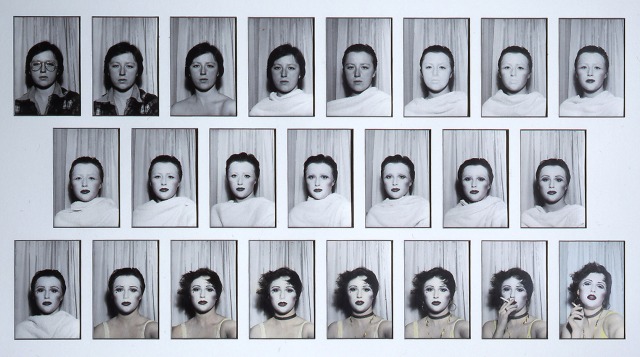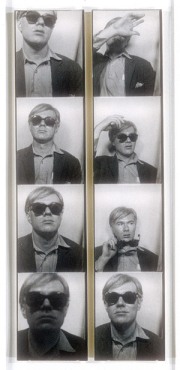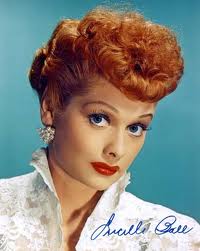When asked which artists influenced her, Cindy Sherman responded, “Definitely Warhol, early on. . . . Definitely he was a big influence.”
Among Sherman’s earliest works Untitled #479 (1975) gives evidence of the creative mode that would become her signature. It also reveals a telling affinity with Warhol’s Photobooth Self-Portraits (c.1963). Sherman has identified this composite of 23 wallet-size pictures—made for a class assignment when she was still a student at Buffalo State College—as her “first serious work.”
Using herself as model and subject, she transforms her appearance by exaggerating her makeup, changing her hairstyle, and diversifying her dress. The addition of such accoutrements as eyeglasses, jewelry, and a cigarette further effect her metamorphosis from a drab girl to a seductive vamp. Burlesque sensations emanate from the mutations. These are coupled with an unsettling aura produced by the figure’s stolid face and unrelenting stare outward. The aura is amplified by the monotonous repetition of her frontal positioning in the exact center of each frame.
Sherman took the photographs in this work with a photo booth—the same device used by Warhol in his earliest experiments with photography. Both artists adopted the medium to create a succession of portrayals conveying the simultaneity of sameness and difference. Both took advantage of the photo booth to explore modes of self-representation and role-playing. Despite their shared affectation of vacant facial expressions, the pre-formulated control of Sherman’s images are distinctive from Warhol’s instantaneous mugging-for-the-camera gesticulations and happenstance body language.
Sherman has spoken of her use of the photo booth with specific reference to her creation of Lucy (1975). “Sometimes I’d go to parties dressed in character. Then, a friend rented a photo booth and I dressed as Lucille Ball. I had a wig that reminded me of her hairstyle.”
Lucy replicates depictions of the legendary actress as she appears in publicity photos: perfectly coiffed and stylishly dressed as a beautiful screen star with the wide-eyed, quizzical gaze of a scatterbrained comedian. But Sherman subtly transforms Lucy into a sad-eyed, withdrawn, apprehensive woman. Dressed in black with her mouth accentuated by a crass smear of dark lipstick, Sherman’s Lucy projects the image of a tawdry, want-to-be movie star posed incongruously as a contemplative thinker.
In her impersonation of Lucille Ball, Sherman asserts a mode of self-portraiture derived from the stereotype roles and fictive personas cultivated in the film industry. She continues this direction in her groundbreaking series, Untitled Film Stills (1977-82). Unlike her Lucy portrait, where she focuses on a specific actress, here she assumes a range of roles inspired by B movies.
 Although subsequent photos did not directly correspondence with movie themes and actresses, an exception occurs in Untitled (as Marilyn) (1982). In this work, Sherman again uses a publicity photo as a point of departure, but to a different end. Her depiction exaggerates the contrived artificiality of Monroe’s temptress pose and defies her personification as a sex goddess. The sultry smile and revealing dress is gone, replaced by a forlorn expression and casual clothes—blue jeans, a loose shirt with rolled-up sleeves, and sporty ankle boots.
Although subsequent photos did not directly correspondence with movie themes and actresses, an exception occurs in Untitled (as Marilyn) (1982). In this work, Sherman again uses a publicity photo as a point of departure, but to a different end. Her depiction exaggerates the contrived artificiality of Monroe’s temptress pose and defies her personification as a sex goddess. The sultry smile and revealing dress is gone, replaced by a forlorn expression and casual clothes—blue jeans, a loose shirt with rolled-up sleeves, and sporty ankle boots.
Sherman’s photos of Lucille Ball and Marilyn Monroe do not directly reference B movies, as do the scenarios in her Untitled Film Stills. Nevertheless, there is an underlying kinship: both Lucy and Marilyn began their careers as B movie stars.
Warhol’s appropriation of publicity photos for his celebrity portraits, especially his iconic Marilyn (1967)—was surely an important aspect of his influence on Sherman. He produced ostentatious images in which lurid colors amplify, camouflage, and distort likenesses, and Sherman fabricated ersatz self-portraits in which she masquerades in unseemly stereotypes of women. The two approaches are strikingly comparable.
One particular work Untitled #108 (1982) virtually replicates Warhol’s preeminent Self-Portrait (1967–one of 11 versions in this historic series). The resemblance is so close that Sherman’s depiction might well be considered an homage to the artist who was “a big influence” on her.
 Both portraits are full face, overtly frontal, and compressed within the pictorial field. Except for a vertical bar on the left side, the surrounding space is monochromatic, totally devoid of detail. Both faces are large-scale, utterly emotionless, and disquieting in the fixity of their piercing gaze at the viewer. The use of glaring, unnatural colors adds an extreme intensity to both portraits. In Sherman’s case the entire image is bathed in fuchsia, whereas Warhol creates flat expanses with a few garish colors. Warhol raises his hand to his mouth in a pseudo-pensive pose in contrast to Sherman who raises her hand atop her shirt, which has been lifted up to reveal the upper part of a bulbous, de-eroticized breast-like form.
Both portraits are full face, overtly frontal, and compressed within the pictorial field. Except for a vertical bar on the left side, the surrounding space is monochromatic, totally devoid of detail. Both faces are large-scale, utterly emotionless, and disquieting in the fixity of their piercing gaze at the viewer. The use of glaring, unnatural colors adds an extreme intensity to both portraits. In Sherman’s case the entire image is bathed in fuchsia, whereas Warhol creates flat expanses with a few garish colors. Warhol raises his hand to his mouth in a pseudo-pensive pose in contrast to Sherman who raises her hand atop her shirt, which has been lifted up to reveal the upper part of a bulbous, de-eroticized breast-like form.
Specific correspondences between Sherman and Warhol bear witness to his influence on her early development. But it was his pioneering inventiveness in the portrait genre and unconventional use of photography that played a general, long-lasting role in shaping her unique mode of creativity.
This commentary was inspired by the Cindy Sherman exhibition, seen at The Museum of Modern Art, New York, and the San Francisco Museum of Modern Art, in 2012.







It seems as though Warhol had an aversion to direct fame, but was never far from the edge of the limelight, whereas Sherman took it on with gusto. Interesting, then, that Sherman sits so comfortably in the spotlight, but Warhol seemed so…enigmatic about it. As though the pupil mastered the one aspect of the discipline that the teacher had never quite conquered.
IMO. LOL.